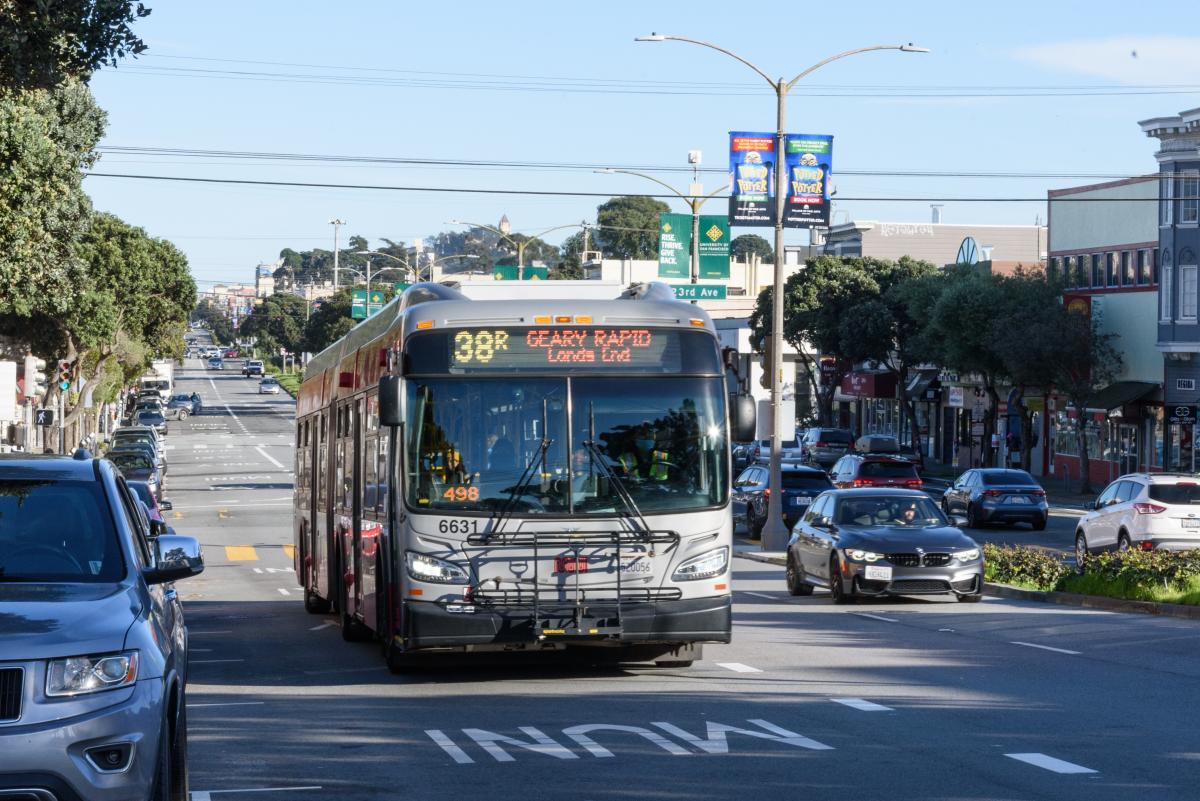
We have been making changes along Geary to improve your trips. See the highlights of our Quick-Build evaluation.
We’re working hard to improve your trips along the Geary corridor, and we want to keep you in the loop about our progress.
We recently completed an evaluation of our “Quick-Build” improvements on Geary. These upgrades are part of the Geary Boulevard Improvement Project, which extends from Stanyan Street to 34th Avenue.
Quick-Build improvements can be done quickly with only paint and signs, but they pack a big punch. These transit and street changes are part of our broader work to reduce Muni delays and improve street safety along the corridor.
We do evaluations like this because we want to be sure that things work as well on the ground as we expected them to on paper. Learn the details of our Quick-Build improvements for Geary and the impact on your trips. And discover what’s coming next when we start construction in 2026 – part of our ongoing effort to improve your experience along the corridor.
Transit investments: Bus trips are shorter and riders can tell
To reduce delays on your 38 Geary rides, we made a few transit improvements along the corridor.
Our teams:
- Moved bus stops. By moving bus stops to the “far side” of the intersection past the traffic signal, we help buses catch more green lights at traffic signals designed to give them priority. This change also makes it safer and less stressful for 38 Geary operators to pull back into traffic after serving a stop because it removes conflicts with vehicles trying to turn right around them.
- Installed dedicated transit lanes. Transit lanes protect buses from getting delayed by traffic, making your bus ride faster. They also help buses get to the front of an intersection. That means our vehicles can take advantage of transit signal priority and spend less time stuck at red lights — even during times when traffic is lighter.
We completed these changes in the fall of 2023. Our evaluation shows:
- Transit travel time decreased by 6-11% after Quick-Build implementation.
- That means 38/38R riders save an estimated 235 hours of travel time every day, collectively!
- Customers noticed the difference: Of bus riders who noted a change after implementation, 85% felt their trip became more reliable.
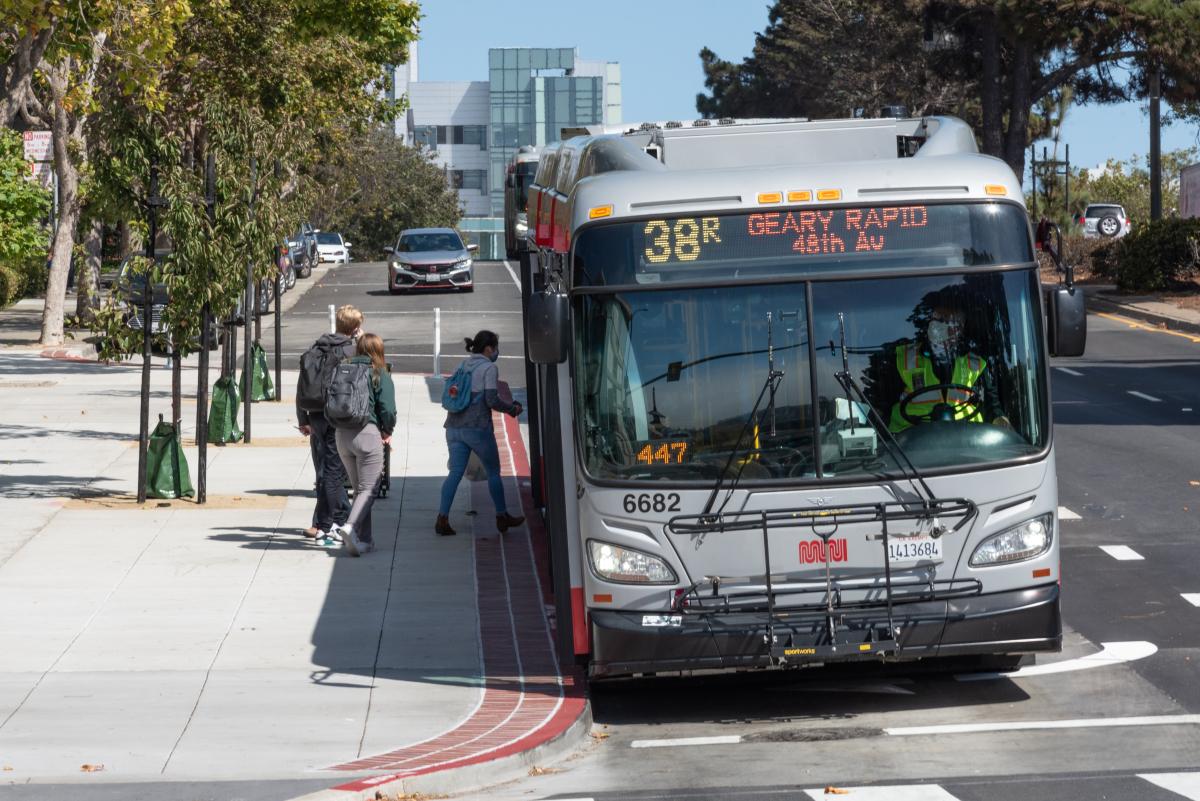
Bus bulbs like this one will be installed at nine more locations during the project’s construction phase. See how they will help improve your trips.
What’s next for Muni?
We’re thrilled to see that our work to reduce Muni delays is already paying off. And starting in 2026, when full-scale construction begins, our teams will build on this progress with more transit upgrades. We will:
- Install bus bulb-outs. These sidewalk extensions at bus stops allow the bus to pull up directly to the stop without leaving the bus lane. This saves travel time because it means buses don’t have to spend time pulling over to the curb and back, which makes for a smoother ride.
- Paint the transit lanes red. This change is shown to improve compliance by 50% because the lanes are more noticeable to drivers. That means fewer traffic delays and more reliable Muni trips.
Improving safety across the corridor: Early investments and next steps
We also made several changes aimed at improving safety during the Quick-Build phase. Our teams:
- Restricted left turns. Left turns are one of the leading causes of fatal collisions. To make Geary safer for people crossing the street, we restricted left turns at 11 locations on the corridor.
- Improved visibility at crosswalks. We painted curbs red at some intersection corners to make it easier for people driving to see people walking. This is known as “daylighting.”
- Changed traffic signal timing. We retimed traffic signals to give people more time to cross the street.
Our evaluation of the Quick-Build safety improvements shows:
- The collision rate of 38/38R buses decreased by 40% compared to the citywide transit collision rate. Our analysis found reductions in:
- “Right hook” collisions. These happen when a car turning right and a bus moving straight collide. This type of collision was likely reduced because we moved many bus stops across the intersection.
- Collisions with cars entering or exiting parking spots. These collisions were likely reduced because we converted angled parking to parallel parking. This change can make it easier to see approaching traffic.
- Rear-end collisions. These collisions were likely reduced thanks to dedicated transit lanes separating buses from most private vehicles.
- Traffic collisions in the project corridor decreased by 1/3.
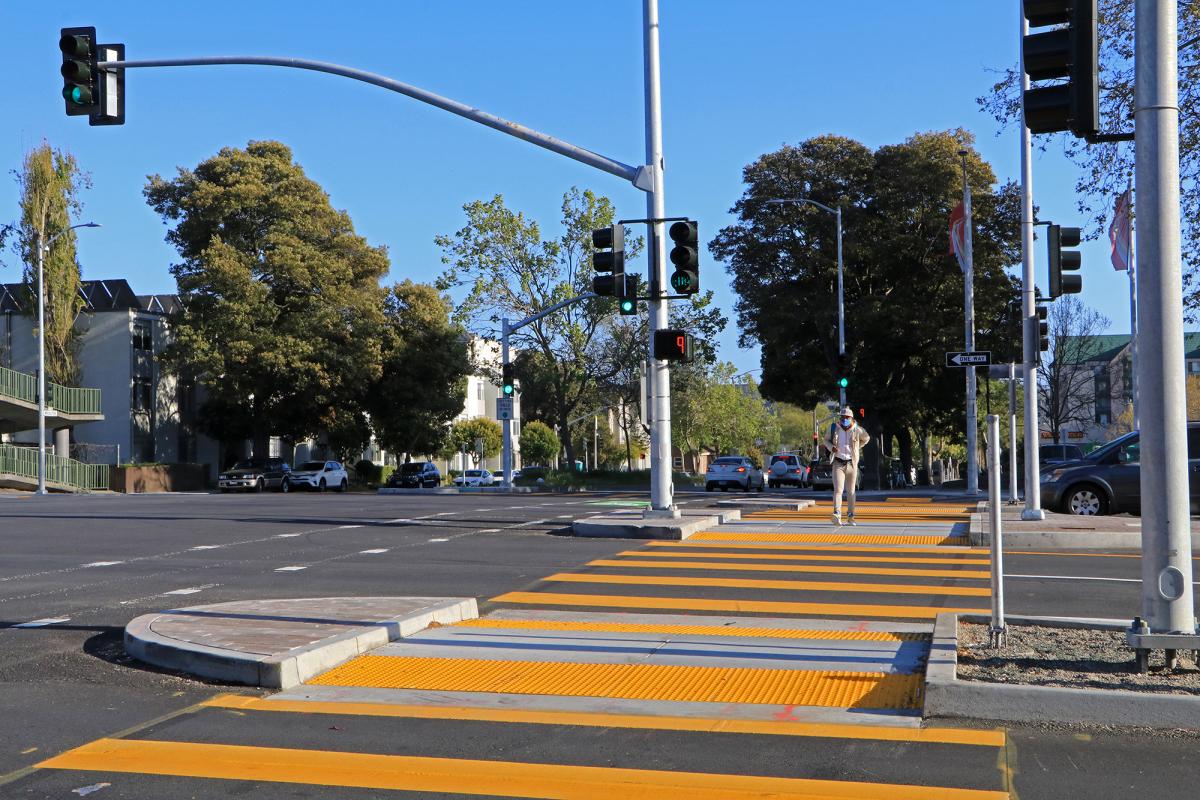
We will install 23 new median refuges during the project’s construction phase. Learn how they can help improve safety.
What’s next for safety?
There’s still a lot more to be done to make Geary safer for people walking on the corridor. A recent pedestrian fatality on this street is a poignant reminder of how critically important it is that we continue this work and make our streets safer for everyone.
When we hear about an injury collision, our team studies the incident closely to understand what happened. If a change to the street design would help prevent a similar type of collision, we work to make that change. We also consider factors beyond street design that may be relevant as a part of San Francisco’s Safe Systems approach to eliminating traffic deaths.
As part of our continued focus on street safety along Geary, we will make a series of upgrades during the project’s construction phase. They include:
- Pedestrian bulb-outs. Bulb-outs improve safety for people walking. By extending the sidewalk into the crosswalk, they make crossing distances shorter. They also encourage cars to make slower turns.
- Median refuges. These are waiting areas in the middle of the street that are protected by concrete. They provide a safe place for people to wait if they can’t finish crossing the street while the light is still green.
- Traffic signal upgrades. We plan to upgrade traffic signals to improve visibility and replace aging equipment. We will install bigger lenses at some intersections so that the color of the signal is easier to spot for people driving. We will also change some traffic signals so the arm hangs over the street instead of alongside it. This is another step to help people driving spot signals.
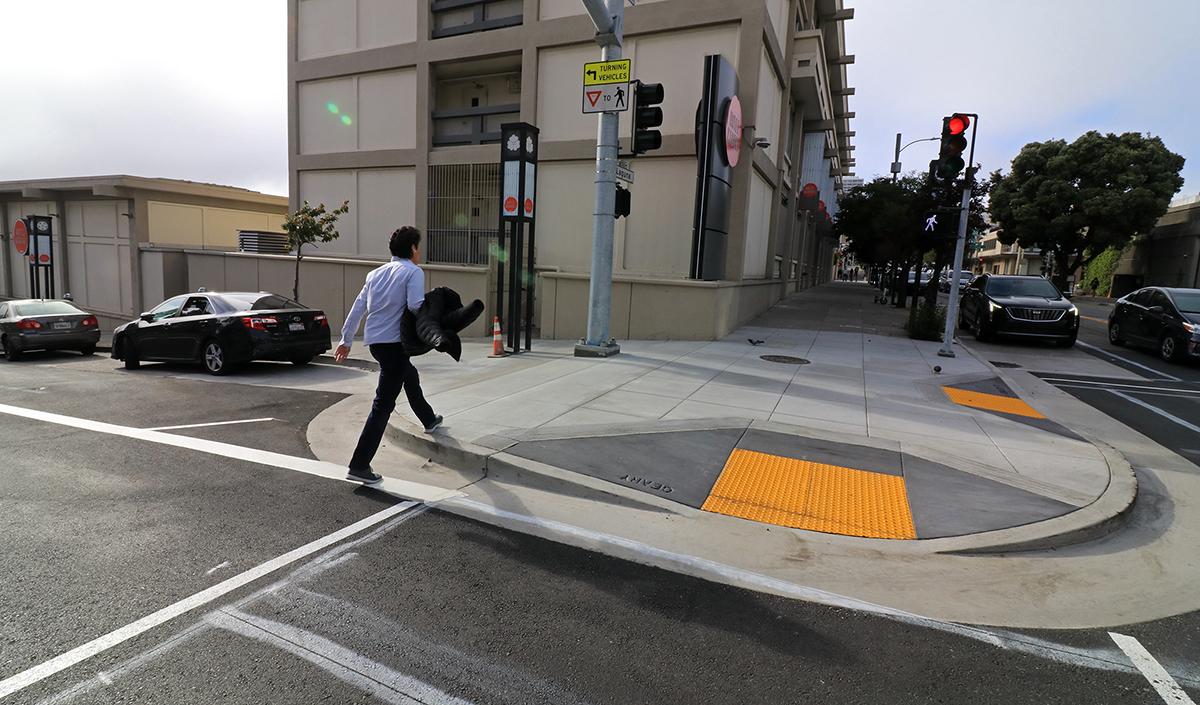
During the construction phase, we will also install 23 pedestrian bulb-outs, similar to this one.
Keeping an eye on potential impacts
During the project’s approval process, we heard some concerns about the project deterring people driving from visiting Geary Boulevard or making it too hard to drive through the Richmond District. So, we included an assessment of these types of impacts.
Our evaluation showed:
- Auto volumes on Geary generally remained steady, with some increases.
- People driving reported visiting Geary as often as before project implementation.
- There was a slight increase in left turn queues, but they remain within acceptable limits.
- Parking availability generally remains within acceptable ranges (over one space per block on average) during metered hours, but decreased since project implementation.
- Median parking search time is less than one minute.
- Geary sales tax receipts performed better than the citywide average, both of which declined slightly.
The finishing touches: Smoother roads and decorative sidewalks
By late 2027, as construction winds down, the project will include a few final touches at street level. They will enhance the look and feel of the neighborhood for years to come.
These upgrades will include:
- Repaving the roadway from curb to curb, making for a smoother ride for everyone.
- New trees. We’re planting about 50 new street trees in the median and on the sidewalk, with species selected by community members.
- Decorative sidewalk designs. Our teams will also install decorative concrete with glass aggregate sidewalk designs at six Rapid bus stops. George Washington High School honors art students created the designs. They will feature the local flora and fauna of the Richmond District.
Ways to explore the Geary corridor and stay in touch
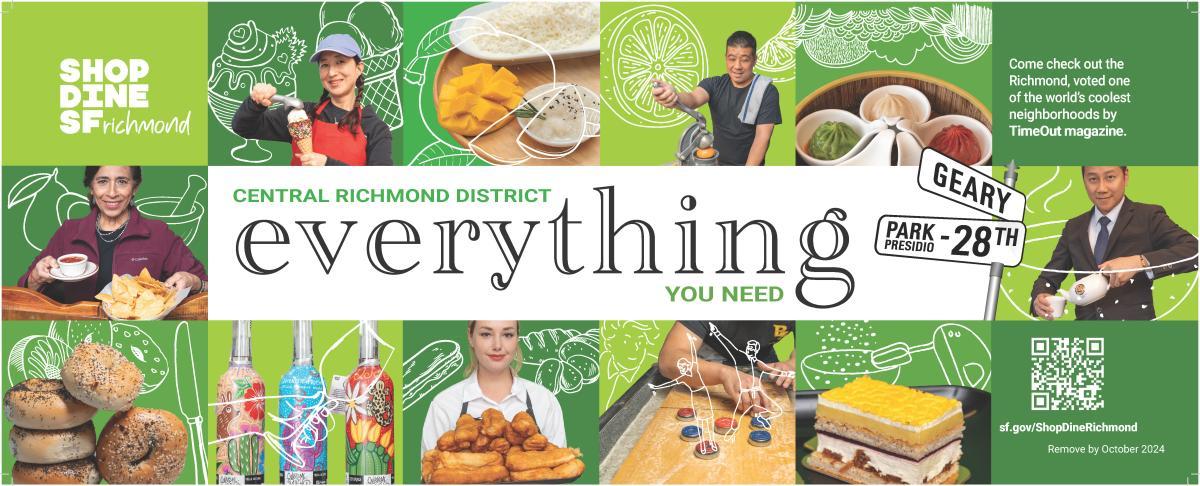
There are lots of small businesses to explore on Geary. You can learn more about them in our blog about an ad campaign highlighting the Central Richmond.
Curious to check out the corridor?
One great way is to stop by the Heart of the Richmond Night Market. The next one is Saturday, August 16 from 4 p.m. to 8 p.m. This vibrant, family-friendly event is a fun way to explore locally owned restaurants and shops. The event happens every third Saturday of the month between June and September. You can catch us there in September with free giveaways and plenty of information about the Geary Boulevard Improvement Project.
And if you’re looking for more inspiration, check out the city’s Perfect Day Central Richmond page. It lists all kinds of ways to stop by the Richmond for food, drinks, entertainment and nature.
To stay in touch about our upgrades on Geary, you can sign up for email or text alerts or visit our project page (SFMTA.com/ImproveGeary).